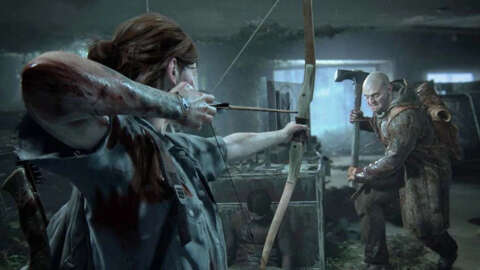
Despite featuring many of the same weapon types, different games have varied ways of tackling how each of them works and feels. Sometimes this evolves through sequels, which is clearly evident when looking how how bows worked between The Last of Us and The Last of Us Part II. The decisions that lead to this change were numerous, according to a senior game designer at Naughty Dog, who has broken down exactly how it works.
In an enlightening thread on Twitter, designer Derek Mattson made the distinction between two popular methods of dealing with projectiles in games. One is used for slower moving ones, such a grenades, where a precise arc of movement can be displayed on screen to show players exactly how an object will move and where it will land, leaving just timing and placement up to the player. This is exactly how the bow in The Last of Us originally worked, with Mattson saying that the arrow could be seen as just a faster-moving grenade.
1. Treat the bow more like a grenade
The original TLOU does this. The 2D reticle is replaced with an in world GUI arc. The player has near perfect info on the path of the projectile. The projectile is no longer shot from the camera and the problem is circumvented all together. pic.twitter.com/kbZ4e3pMKf— Derek Mattson (@thedmatts) July 18, 2023
The downside to this approach, as Mattson continues, is a lower skill ceiling and a possible trade-off in satisfaction, since the ambiguity of where an arrow will land is completely removed. That’s where a second approach offers a solution, with Mattson using Tomb Raider as an example. He theorises that it uses a method that most firearms use in games, where the projectile doesn’t originate from the weapon but rather from the point on the player camera where the reticle is pointing. This works well for fast projectiles, such as bullets, but can lead to a disconnect with a bow and arrow as the animation of the string on the bow can misalign with the speed and trajectory of the arrow, diminishing the feel of the entire action.
The second probe comes from the bow.
We use the projected collision point from the initial probe to back calculate the arc of the 2nd probe.
This probe is what has the art. The arrow, the tracer fx, etc.
But the key to this probe is that it only collides with enemies! pic.twitter.com/yc8tXm0PE7— Derek Mattson (@thedmatts) July 18, 2023
The solution that The Last of Us Part II eventually arrived at was a combination of the two. As Mattson describes, the game fires the projectile, in this case an arrow, from the camera, although this isn’t visible to the player. A second arrow then uses the endpoint of that first, invisible one, to calculate its trajectory from the bow, making the entire motion seem like it originates from where it should but its collision detection take place across an axis that makes more sense from the perspective of a player’s aim. The collisions from the secondary arrow only look for enemies, while those from the invisible first one detect everything, which Mattson says helps avoid issues of a player being unable to shoot from around a tight angle with a wall.
The entire thread isn’t too long but it does make for a fascinating peek at just once facet of a much larger collection of moving parts, and one that probably takes a lot more thought than you might expect–just like the complex system used in The Last of Us Part II for its impressively reactive and realistic glass simulation.
The products discussed here were independently chosen by our editors.
GameSpot may get a share of the revenue if you buy anything featured on our site.

